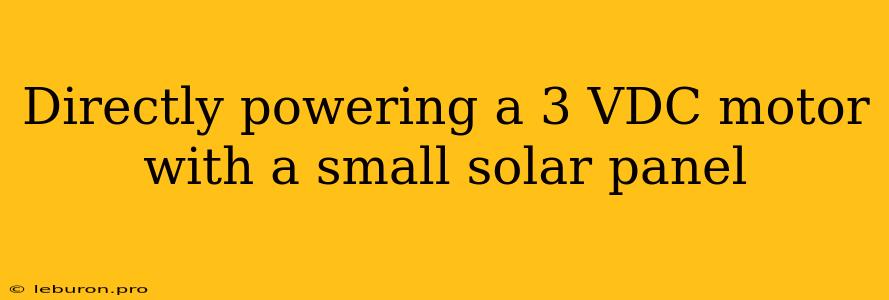Harnessing the power of the sun to drive small motors is a fascinating prospect, offering possibilities for sustainable and self-powered devices. A common question arises: can a small solar panel directly power a 3 VDC motor? The answer, while not a simple yes or no, involves understanding the intricacies of solar panel output, motor requirements, and the factors that influence their compatibility. This article delves into the practicality of directly powering a 3 VDC motor with a small solar panel, exploring the considerations, potential challenges, and solutions to achieve this goal.
Understanding the Components
Solar Panels: Powering the System
A solar panel converts sunlight into electrical energy, producing a direct current (DC) voltage. The output of a solar panel depends on its size, efficiency, and the intensity of sunlight. Smaller solar panels, often used for hobby projects or powering small devices, typically produce a voltage range of 3 to 6 volts. However, their current output is limited, and the voltage might fluctuate based on the sun's position and weather conditions.
DC Motors: Converting Electrical Energy to Motion
A DC motor operates on direct current, converting electrical energy into mechanical energy. These motors are classified by their voltage rating, with 3 VDC motors being commonly used in small applications like toys, robots, and miniature pumps. The motor's power consumption depends on its size and the load it needs to handle.
Challenges of Direct Powering
Connecting a solar panel directly to a 3 VDC motor might seem straightforward, but several challenges can arise:
- Voltage Mismatch: The voltage output of a small solar panel can vary, especially in changing sunlight conditions. A 3 VDC motor requires a consistent 3 volts to operate efficiently. If the solar panel voltage drops below 3 volts, the motor may not start or run at full speed. Conversely, if the voltage exceeds 3 volts, it can damage the motor.
- Current Limitations: Small solar panels have limited current output, which might not be sufficient to power a 3 VDC motor with a significant load. This can lead to the motor running sluggishly or not starting at all.
- Sunlight Fluctuations: The intensity of sunlight is constantly changing throughout the day. This variation directly affects the voltage and current output of the solar panel, causing fluctuations in motor performance.
Solutions and Considerations
To overcome these challenges, several strategies can be employed:
1. Choosing the Right Solar Panel
Selecting a solar panel with an output voltage slightly higher than the motor's operating voltage can ensure consistent performance. This allows for a small margin of error in sunlight fluctuations. However, it's crucial to choose a panel that does not exceed the motor's maximum voltage rating to prevent damage.
2. Utilizing a Voltage Regulator
A DC-DC voltage regulator provides a stable and regulated output voltage, regardless of the input voltage from the solar panel. This ensures a constant 3 volts to the motor, guaranteeing consistent performance even under varying sunlight conditions.
3. Employing a Battery
A small battery can store the energy produced by the solar panel and provide a stable power source to the motor. This approach is particularly useful when the motor needs to operate consistently even during periods of low or no sunlight. The battery acts as a buffer, ensuring continuous power supply to the motor.
4. Considering Load Requirements
The power required to operate a 3 VDC motor is determined by its load. If the motor needs to handle a significant load, it might require more power than a small solar panel can provide. In such scenarios, a larger solar panel or a combination of solar panels might be necessary to meet the motor's energy demand.
Example Scenario: Solar-Powered Robot
Imagine building a small solar-powered robot. The robot's movement is driven by a 3 VDC motor. To ensure smooth operation, a voltage regulator can be used to provide a stable 3 volts to the motor, regardless of the solar panel's fluctuating voltage. A small battery can be incorporated to provide power even when the robot is in shaded areas or during periods of low sunlight.
Conclusion
Directly powering a 3 VDC motor with a small solar panel is achievable but requires careful consideration of the factors involved. Understanding the voltage and current requirements of both the motor and the solar panel is crucial. Employing solutions like voltage regulators, batteries, and selecting an appropriate solar panel can enhance the efficiency and reliability of the system. The integration of solar energy with small motors opens up possibilities for innovative and sustainable applications, contributing to a future where renewable energy sources power everyday devices and technologies.
